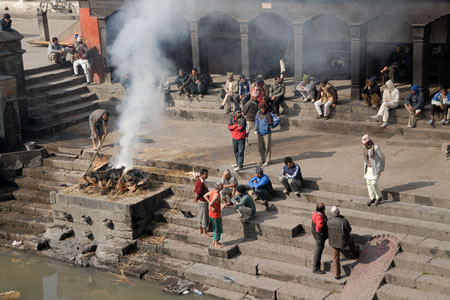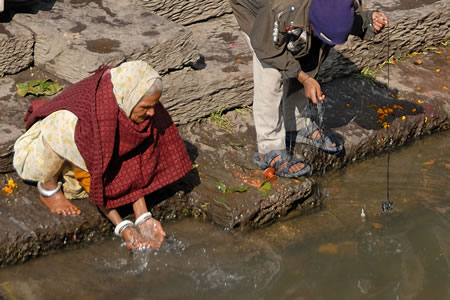English | Dutch |
|
| Pashupatinath: Life and death, close to each other | |
Kathmandu (Nepal), January 3rd 2008 |
|
Pashupatinath is one of the places in Nepal that we really want to see, but where we are not looking forward to. Pashupatinath is one of the most important Hindu temples in Nepal and is located near the Bagmati River. At the ghats (stairs where you can descend to the river), plateaus are made that are used for the open air cremations that take place on a daily basis. The Pashupatinath temple is not accessible for non-Hindus but it is the cremations that attract many visitors, both Nepalese and foreign visitors. Cremations are part of life and death, but it is something that you do not want to be confronted with to many times. Especially Ivonne was reluctant to visit Pashupatinath. Cremations at Pashupatinath are not the same as in the western world, where the cremation is something private. As soon as we approach the Bagmati River, we see already the smoke of a cremation that is taking place. In Nepal, also the death people are not equal. There are several cremation places, one for the royal family, one for rich families with prestige and several others for the ‘normal’ people. The cremation places for the ‘normal’ people are located on the other side of the bridge, out of sight from the places that are used by the royals and the rich. From the other side of the river you can observe all the activities that are going on. Ivonne is relieved when she sees that the human body is not recognisable anymore because the cremation is already almost at the end. The fire is managed by two persons, who seem to be close family. They use long bamboo sticks to poke in the fire and to be sure that everything burns well. Along the cremation fire, a young man with a shaven head sits on the stairs that lead to the river. He is the oldest son of the man that is being cremated. It is difficult to understand for us that he is sitting so quietly while his father is being cremated. It is impressive, but because of the serenity, it is not grisly. When the cremation is over, the relatives descend to the river. The oldest son puts of his cloths and throws them into the river. Afterwards he clothes himself completely in with as a sign that he is starting his mourning period, which will last for a year. He will wear white clothes for a whole year. |
|
 |
|
Open air cremation at the holy Bagmati river in Pashupatinath |
|
After a while, we see some activity that is going on at one of the cremation places for the normal people. People are preparing a cremation by accumulating wood on the plateau. Next to the activities, we see a stretcher with a body on it. After the cremation place is prepared, the close relatives carry the stretcher with the body to the temple for a last visit. The deceased is covered by a white cloth and after the last visit to the temple, the close relatives undress the body discreetly. Afterwards, the cloths are thrown in the holy Bagmati River and the body is winded in white fabrics. Only the head stays visible. The close relatives (only men) pick up the body from the stretcher and carry it three times around the pile of wood of the cremation place (in clockwise direction). After they put the deceased on the pile of wood, the oldest son walks three times around the body with a lighted piece of wood. Afterwards he kindles the pile of wood near to the mouth of the dead body. This place is important because the Hindus believe that the spirit of the deceased leaves the body via the mouth. We observe all the rituals from the other side of the river, together with a lot of local people and some other foreigners. Almost everybody takes appropriate distance from the location where the cremation takes place, except one foreigner. A Japanese guy manoeuvred himself to a spot only a couple of metres away from the plateau. Photography is allowed, but local people hope that visitors (both local and foreigners) keep appropriate distance. Without any shame, he tries to improve his spot by moving little by little, closer to the deceased. Just after the Japanese guy got his camera and telephoto lens out of his bag, fortunately a priest tells him to take more distance. As soon as the pile burst into flames, the body is covered with wet straw. The straw is soaked with water from the holy Bagmati River what results in a lot of white smoke. The head of the deceased is not visible anymore and now the waiting for the close relatives start till the body is completely burnt. This takes several hours. | |
 |
|
Boy is 'fishing' for coins with a rope and magnet |
|
| It gives a double feeling to be on this holy place. In our western culture it is unthinkable that relatives are cremated in a public environment. It would be even more unthinkable to cremate relatives while foreigners are making pictures of the ‘event’ and are paying an entrance fee. People here in Nepal are used to it, as long as visitors keep appropriate distance and be respectful to the people who cremate their love ones on this special place. Pashupatinath is a place where you are explicitly confronted with life and death. While some people are cremating a relative on one of the plateaus along the river, only a couple of metres away, devotees are taking a ritual bath in the same holy river.
While most activities that takes place near the river and temple have a religious spirit, you will also see people around who are there for the money. Just after the moment that devotees offered coins to the holy river, young boys appear equipped with a rope and magnet, who try to ‘fish’ the coins out of the river again. After the magnet is thrown in the river, they pull the rope so that the magnet is dragged over the bottom of the river. Once in a while you see the boys run away when a police officer is around. It is a cat and mouse game between the supervisors and the boys who try to ‘earn’ some money. We saw one boy who was caught by a supervisor and who had to hand over his rope and magnet. After he got a box on the ear, he was released again. Time again to find a new rope and magnet! These boys are not the only persons that hang around Pashupatinath to earn some money. Pashupatinath attracts as a holy place a lot of sadhus (holy men). These men with their colourful painted faces and their long Rasta hair know that they are very photogenic. If somebody takes a picture of them, they immediately beg for alms. Sadhus do officially depend on gifts, but posing for pictures seems to be big business for them too. After being in Pashupatinath for several hours, also Ivonne feels that the visit to Pashupatinath is better than expected. The serene atmosphere makes it a peaceful place. In spite of the fact that people here also are in distress because of the loss of the love ones, they deal with it differently in comparison to us in the west. It is questionable who long local people will accept it that local people and foreigners come to this place to ‘watch’ a cremation. If more and more people visit this place without having the respect to treat people appropriately, they will probably restrict this place in the future and make it only accessible for the people who come to cremate their relatives or friends. Of course, in that case the temple will lose the entrance fees that foreigners pay to see the cremations, but it is not all about the money, is it? The boys that ‘fish’ the Bagmati River for the coins, probably disagree with this. | |